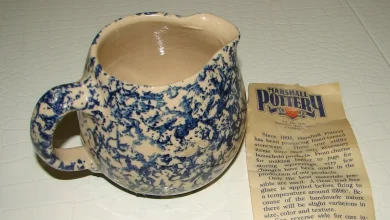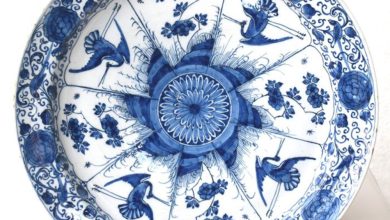What Temperature Is a Pottery Kiln
The temperature of a pottery kiln can vary depending on the specific type and purpose of the kiln.
Generally, pottery kilns can reach temperatures ranging from around 1,800 to 2,400 degrees Fahrenheit (980 to 1,315 degrees Celsius).
The ideal temperature for firing clay in a kiln typically falls within this range, although the specific temperature may differ based on the type of clay and desired outcome of the firing process.
Pottery kilns are often divided into different temperature zones to accommodate various stages of firing, such as bisque firing and glaze firing.
Maintaining a consistent temperature is crucial in a pottery kiln to ensure proper firing and glaze results.
Factors that can influence the temperature within a kiln include the type of fuel or heat source used, kiln design, and the size and thickness of the pottery being fired.
Kilns may have temperature control options, such as controllers or pyrometers, to monitor and adjust the temperature as needed.
It is important for potters to understand the temperature gauge in a kiln and to regularly monitor the temperature during the firing process to achieve the desired outcome for their pottery.
Did You Know?
1. The temperature range for a pottery kiln can vary depending on the type of clay and glaze being used, but typically ranges from 1,800 to 2,400 degrees Fahrenheit (982 to 1,316 degrees Celsius).
2. Pottery kilns have been used for thousands of years, with evidence of their existence dating back to 6,000 BCE in places like China, Egypt, and Mesopotamia.
3. In ancient times, kilns were often built partially underground to take advantage of the insulating properties of the earth, helping to maintain a more consistent temperature during firing.
4. The color of the pottery inside a kiln can change depending on the firing temperature. For example, a lower firing temperature can result in a more pale or pastel-colored finish, while a higher temperature can lead to a deeper and more vibrant color.
5. Modern pottery kilns are equipped with advanced temperature control systems, allowing potters to precisely monitor and regulate the firing process. This allows for more consistent results and reduces the risk of damage to the pottery.
Temperature Range For Pottery Kilns
When firing pottery kilns, temperature plays a crucial role. Kilns are designed to reach high temperatures to transform clay into ceramic objects. The temperature range for pottery kilns can vary depending on the type of kiln and the desired outcome. Most commonly, electric kilns have a temperature range of 1,800 to 2,400 degrees Fahrenheit (982 to 1,315 degrees Celsius). However, gas-fired kilns can reach even higher temperatures of up to 2,700 degrees Fahrenheit (1,482 degrees Celsius).
It is essential to carefully select the temperature range for a kiln to suit the specific needs of the clay being fired and the desired final result. Achieving the right temperature in a pottery kiln is crucial for successful firing. Factors such as the type of clay being used, the desired outcome, and the technical specifications of the kiln should be considered.
If the kiln is not heated to the appropriate temperature, the clay may not vitrify properly, resulting in weak or brittle ceramic objects. On the other hand, if the kiln is heated too high, the clay may become overfired, leading to distortion or even melting of the objects.
Ideal Temperature For Firing Clay
The ideal temperature for firing clay in a pottery kiln depends on several factors, including:
- Type of clay
- Desired outcome
- Specific characteristics of the kiln
Typically, the firing temperature for pottery ranges from 1,800 to 2,400 degrees Fahrenheit (982 to 1,315 degrees Celsius). Within this range, different clay types will undergo various transformations.
For example, earthenware clay, which is low-fired, typically requires a temperature range of 1,800 to 2,000 degrees Fahrenheit (982 to 1,093 degrees Celsius). Stoneware clay, which is fired at a medium temperature, generally requires a range of 2,200 to 2,400 degrees Fahrenheit (1,204 to 1,316 degrees Celsius). Lastly, porcelain clay, which is high-fired, usually needs a temperature range of 2,400 to 2,600 degrees Fahrenheit (1,316 to 1,427 degrees Celsius).
It is important to note that the ideal temperature for firing clay may vary depending on the specific properties of the clay and the desired final result. Thus, it is crucial for potters to carefully assess and understand their materials to achieve the desired outcome.
*
Different Temperature Zones In A Kiln
Understanding the different temperature zones in a pottery kiln is essential for controlling the firing process and achieving the desired results. There are three main temperature zones in a kiln:
-
The preheat zone, also known as the drying zone, is the first section of the kiln where moisture is driven out of the clay. This zone typically ranges from room temperature up to around 200 degrees Fahrenheit (93 degrees Celsius). During this phase, the kiln heats up gradually to avoid cracking or exploding the clay due to rapid water evaporation.
-
The firing zone is the main section of the kiln where the clay undergoes its chemical and physical transformation. This zone is characterized by the highest temperatures, ranging from the specific firing temperature of the clay up to the maximum temperature of the kiln. It is in this zone that the clay vitrifies and transforms into a durable ceramic material.
-
The cooling zone is the final phase of the firing process. After reaching the desired firing temperature, the kiln will gradually reduce in temperature to room temperature. This slow cooling process is crucial to prevent thermal shock and ensure the stability of the ceramic objects.
Remember:
- Preheat zone: moisture is driven out of the clay.
- Firing zone: clay undergoes chemical and physical transformation.
- Cooling zone: kiln gradually cools to prevent thermal shock.
Temperature’s Impact On Glaze
Temperature is a crucial factor in the development of glazes in a pottery kiln. Glazes are composed of specific minerals and materials that melt at certain temperatures to form a smooth and glassy surface on ceramics. The firing temperature has a significant impact on the appearance, texture, and durability of the glaze.
When firing at lower temperatures, glazes tend to have a matte or satin finish. This occurs because the minerals in the glaze do not fully melt, resulting in a less smooth surface. Conversely, firing at higher temperatures produces a glossy finish as the glaze melts and becomes more fluid.
Furthermore, the temperature influences the color of the glaze. Some glazes may change color depending on the firing temperature. For instance, certain copper-based glazes can appear green at lower temperatures but transform into red or brown at higher temperatures.
To achieve the desired results, it is essential for potters to test their glazes at different temperatures. By understanding the relationship between temperature and glaze, potters can create unique and beautiful ceramic objects.
- Glazes are made up of minerals and materials that melt at specific temperatures
- Firing temperature determines appearance, texture, and durability of glaze
- Lower temperatures result in matte or satin finish, while higher temperatures yield a glossy finish
- Some glazes undergo color changes at different firing temperatures
- Testing glazes at various temperatures is crucial for achieving desired results
Recommended Bisque Firing Temperature
Bisque firing is a crucial step in pottery-making, occurring before the final glaze firing. This process not only removes moisture from the clay but also strengthens it for glazing.
The recommended temperature for bisque firing generally falls between 1,700 to 1,900 degrees Fahrenheit (927 to 1,038 degrees Celsius). Within this range, the clay undergoes chemical changes that transform it into a porous yet robust ceramic material. Bisque firing also prepares the clay’s surface for glaze application, ensuring proper adhesion during the final firing.
It’s important to consider that the specific temperature for bisque firing may vary depending on the clay type and desired outcome. Some clays require higher or lower temperatures to achieve the desired vitrification level.
In summary, temperature plays a fundamental role in pottery firing. Having an understanding of the ideal firing temperature for clay, the temperature range for pottery kilns, the different temperature zones in a kiln, the influence of temperature on glaze, and the recommended bisque firing temperature is crucial for potters aiming to create successful and beautiful ceramic pieces. By diligently monitoring and controlling temperature, potters can unleash their creativity and produce unique works of art.
Check this out:
Frequently Asked Questions
How hot does a pottery kiln need to be?
In order to transform clay into durable and non-water soluble pottery, the temperature of a pottery kiln needs to reach at least 1,400 degrees Fahrenheit (760 degrees Celsius). This level of heat is necessary to eliminate the molecular water present in the clay and convert the clay molecules into a state where they no longer dissolve or slake in water. However, with the advancements in technology in modern societies, kilns are capable of reaching even higher temperatures, ranging from 1,800 to 2,400 degrees Fahrenheit (980 to 1,315 degrees Celsius), to produce pottery and bricks with enhanced strength and durability. These elevated temperatures allow for the complete firing and vitrification of the clay, resulting in high-quality ceramic products.
Can you use an oven as a kiln?
While a kitchen oven can reach high temperatures necessary for firing ceramics, it is not ideal for using as a kiln. Kilns are specifically designed with insulation and ventilation systems to ensure even heating and proper circulation of air. A kitchen oven lacks these features, resulting in uneven heating and potentially damaging the ceramics. Additionally, using an oven as a kiln can release harmful chemicals from the glazes and clay materials, posing a health risk. Therefore, it is best to invest in a proper kiln or seek alternative methods for firing ceramics.
What temperature is porcelain fired in Celsius?
Porcelain is a type of ceramic material that is fired at exceptionally high temperatures. Specifically, porcelain is typically fired between 1305℃ and 1346℃ (2381℉ and 2455℉) in Celsius. This high firing temperature distinguishes porcelain from other ceramic materials such as earthenware and stoneware, as it requires a significantly hotter environment to reach its desired level of maturity.
Can I fire pottery without a kiln?
Unfortunately, firing pottery without a kiln is not recommendable. While it is true that most clays can become earthenware ceramics at temperatures around 700° Celsius, achieving such high temperatures without a kiln can be challenging. Although a well-built campfire might reach the required temperature, it is important to consider safety and legal regulations concerning open fires. Additionally, the heat distribution and control in a campfire might not be sufficient for successful pottery firing, resulting in inconsistent and unpredictable results. To ensure proper and reliable pottery firing, using a kiln specifically designed for this purpose is the most suitable option.

